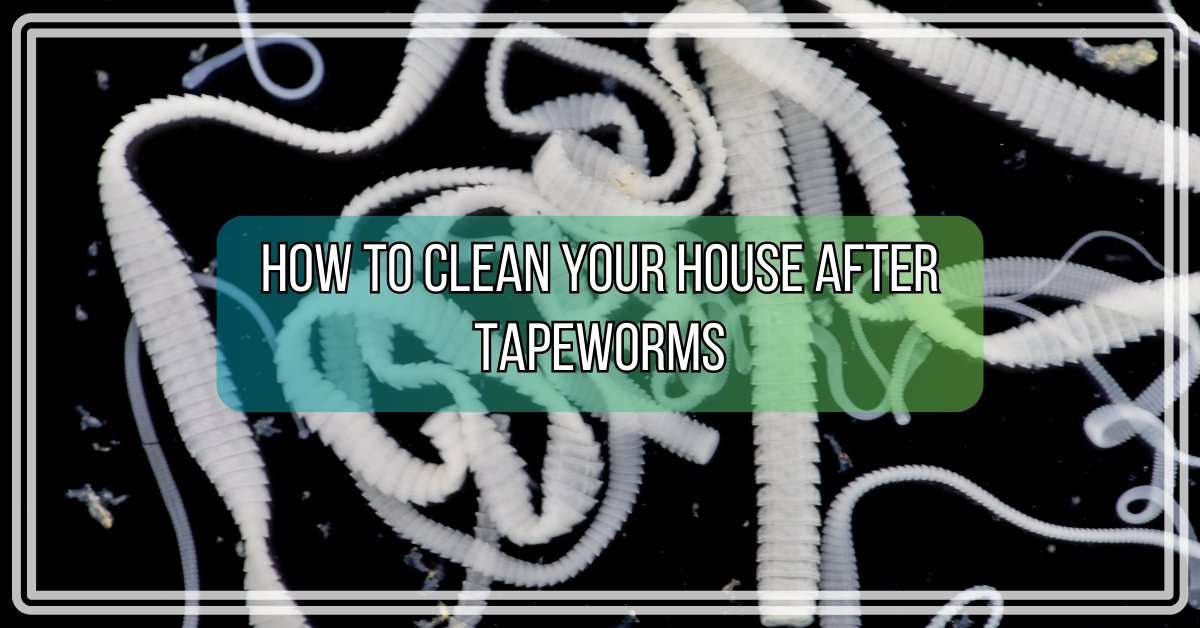Dealing with tapeworms in your home can be daunting and unpleasant. These parasites not only affect the health of your pets but can also impact your well-being. Once you’ve tackled the source of tapeworms, usually by treating your infected pets, it’s crucial to thoroughly clean your home to eliminate any lingering eggs or larvae. Here’s how to ensure your house is clean and safe after a tapeworm infestation.
Remove The Source of Tapeworms
Removing the source of tapeworms is an essential first step in reclaiming your home from these unwelcome parasites. Tapeworms can make their way into your living space through your pets, who are the most common carriers. The journey to a tapeworm-free home starts with a visit to the veterinarian. Your vet can diagnose the issue and provide the necessary medication to rid your pets of these parasites effectively. It’s important to complete the full treatment course as prescribed to eliminate all tapeworms.
However, treating your pets is only part of the solution. Fleas are often the culprits that carry tapeworm eggs, which then get ingested by your pets during grooming. Therefore, alongside tapeworm treatment, you must also tackle any flea infestations. There are various flea treatment options available, including topical treatments, oral medications, and flea collars. Your vet can recommend the best flea prevention strategy for your pets, taking into account their specific needs and any health concerns.
With your pets on their way to recovery, you can sigh relief—but don’t relax just yet. It’s now crucial to focus on your home environment. Tapeworm eggs can linger in the spaces where your pets sleep, play, and eat, waiting for the next host. Cleaning and disinfecting your home thoroughly will help prevent reinfestation and protect the health of both your pets and your family. Remember, the fight against tapeworms is a two-front battle: treating your pets and cleaning your home are equally important steps in ensuring these parasites are gone for good.
House Cleaning After Tapeworms
After addressing tapeworms in your pets, the next critical step is a thorough house cleaning. This phase is vital for eliminating any remaining tapeworm eggs from your living environment, ensuring your home is safe and healthy for everyone. A strategic approach to cleaning can significantly reduce the risk of reinfestation, keeping your pets and family protected.
Let’s dive into how to effectively clean your house after a tapeworm outbreak, focusing on key areas and methods to target these resilient parasites.
Step 1. Clean Up After Pets More Often
Start with the basics: clean up after your pets more diligently than ever. Tapeworm eggs can be present in your pet’s feces, so it’s essential to dispose of their waste promptly and safely. Regularly wash your hands after handling your pet or cleaning up after them to avoid accidental ingestion of tapeworm eggs.
Step 2. Vacuum Thoroughly
Vacuuming is your best friend in the fight against tapeworms. Carpets, rugs, and upholstered furniture can harbor tapeworm eggs. Use a powerful vacuum cleaner to cover every inch of your home, paying extra attention to the areas where your pets spend most of their time. Dispose of the vacuum bag or clean the vacuum canister outside to prevent any eggs from spreading back into your home.
Step 3. Steam Cleaning
After vacuuming, steam cleaning carpets and furniture adds an extra layer of security. The high steam temperature can kill tapeworm eggs, ensuring they don’t hatch and lead to a new infestation. If you don’t own a steam cleaner, consider hiring a professional cleaning service to do a deep clean.

Step 4. Clean Animal Bedding
Your pet’s bedding is a hotspot for tapeworm eggs. Wash all bedding, blankets, and any washable items your pet uses in hot water. If possible, add a small amount of bleach to the wash to ensure all parasites are killed. Dry these items on the highest heat setting to eliminate any remaining eggs.
Step 5. Clean Solid Surfaces
Tapeworm eggs can also linger on solid surfaces like floors, countertops, and pet feeding areas. Use a disinfectant cleaner safe for pets to wipe down these areas. Use a suitable cleaner for wooden floors that won’t damage the wood while ensuring it cleans effectively.
Step 6. Clean Outside
Remember your outdoor spaces, especially if your pets spend a lot of time there. Remove feces promptly and consider treating your yard with an environmentally safe pesticide to control flea populations, which are often carriers of tapeworm eggs.
Step 7. Clean Yourself
Finally, personal hygiene is crucial during and after the cleaning process. Wash your hands frequently, especially after cleaning or coming into contact with your pets. Showering and changing into clean clothes after finishing your cleaning tasks can also help prevent the spread of tapeworm eggs.
Tapeworms FAQs
How Long Can Tapeworms Survive on Carpet?
Tapeworm eggs can survive in carpets for several months under the right conditions. The survival time can vary based on environmental factors such as temperature and humidity. Warmer and more humid environments can prolong their viability, making it essential to regularly clean and vacuum carpets, especially in homes with pets.
Regular cleaning not only helps to remove tapeworm eggs but also reduces the population of fleas, which are vectors for tapeworms. To manage tapeworm risks effectively, consider steam cleaning carpets periodically, as the heat can kill tapeworm eggs and larvae.
Does washing bedding kill tapeworms?
Yes, washing bedding can effectively kill tapeworm eggs and larvae, provided it’s done correctly. High temperatures are crucial for eliminating these parasites. To ensure you’re effectively killing tapeworms:
- Use Hot Water: Wash the bedding in hot water, ideally at least 140°F (60°C). Most household washing machines have a hot water cycle that can reach these temperatures.
- Add Laundry Detergent: Use a good quality laundry detergent. Detergents can help to break down and remove organic matter and parasites.
- High-Heat Drying: After washing, dry the bedding in a high-heat setting. The combination of hot water washing and high-heat drying effectively kills tapeworm eggs and ensures that your bedding is safe to use again.
Remember, it’s also important to clean and disinfect other areas where pets rest and play and to maintain regular flea control measures to prevent tapeworm reinfestation.
What kills tapeworm eggs in the house?
To effectively kill tapeworm eggs in your house, focus on steam cleaning and hot water washing, as high temperatures are crucial for eliminating these parasites. Regular vacuuming of floors, carpets, and furniture helps remove eggs, especially in areas frequented by pets.
Use disinfecting cleaners on hard surfaces, ensuring they’re safe for pets and humans, and manage outdoor spaces to reduce flea populations, the primary carriers of tapeworm eggs. Additionally, maintaining rigorous flea control on your pets is essential to prevent reinfestation.
Integrating these practices into your cleaning routine can create a safer environment for your family and pets.
Cleaning your house after a tapeworm infestation might seem overwhelming. Still, it’s a necessary step to protect the health of your family and pets. By following these thorough cleaning steps, you can significantly reduce the risk of reinfestation. Remember, the key to preventing tapeworms is ongoing vigilance—regularly treat your pets for fleas, maintain cleanliness in your home, and practice good personal hygiene. With these measures in place, you can keep your living environment safe and tapeworm-free, ensuring peace of mind for you and your loved ones.

